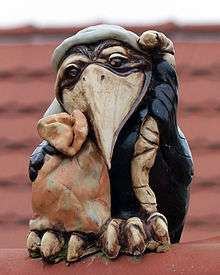Krabat
Krabat is a character in Sorbian folklore, also dubbed the "Wendish Faust". First recorded in 1837,[1] the character developed from an evil sorcerer into a folk hero and beneficial trickster in the course of the 19th century.

Origins
The historical nucleus of the folk tale is Johannes Schadowitz (1624–1704), a Croat (Crabat) cavalry commander, who was granted an estate in Groß Särchen (now part of Lohsa) near Hoyerswerda in 1691 by John George III, Elector of Saxony.
Analysis
The tale of Krabat's apprenticeship to an evil sorcerer with malefic powers can be classified, in folkloristic studies, as Aarne-Thompson-Uther ATU 325, "The Sorcerer's Apprentice".[2]
Distribution
The folk tale is centered around the area of Lusatia, most notably the settlement of Čorny Chołmc, which today is a district of the city of Hoyerswerda, where Krabat is said to have learned his sorcerous powers.[3]
Adaptations
The Krabat story has been adapted into several novels, notably:
- Mišter Krabat (Master Krabat) (1954) by Měrćin Nowak-Njechorński.
- Čorny młyn (The Black Mill) (1968) by Jurij Brězan, on which the film Die Schwarze Mühle was based.
- Krabat (1971) by Otfried Preußler, which inspired the Czech film Čarodějův učeň (1977) and the German film Krabat (2008). The Krabat album by German Goth band ASP is also inspired by this version of the legend.
References
- Joachim Leopold Haupt, Von einem bösen Herrn in Groß-Särchen (1837)
- Troshkova, A (2019). "The tale type 'The Magician and His Pupil' in East Slavic and West Slavic traditions (based on Russian and Lusatian ATU 325 fairy tales)". Indo-European Linguistics and Classical Philology. XXIII: 1022–1037. doi:10.30842/ielcp230690152376.
-
- Zipes Jack, ed. (2017). The Sorcerer's Apprentice: An Anthology of Magical Tales. Illustrated by Natalie Frank. Princeton University Press. ISBN 978-1-4008-8563-3. pp. 323-348.
Bibliography
- Jurij Pilk, Adolf Anders, "Der wendische Faust", Sächsischer Erzähler. Illustrierte Beilage, Nr. 14 (1896), reprinted as "Die wendische Faust-Sage", Bunte Bilder aus dem Sachsenlande vol. 3 (1900), 191–201.
- Zipes Jack, ed. (2017). The Sorcerer's Apprentice: An Anthology of Magical Tales. Illustrated by Natalie Frank. Princeton University Press. ISBN 978-1-4008-8563-3.
- Troshkova, A (2019). "The tale type 'The Magician and His Pupil' in East Slavic and West Slavic traditions (based on Russian and Lusatian ATU 325 fairy tales)". Indo-European Linguistics and Classical Philology. XXIII: 1022–1037. doi:10.30842/ielcp230690152376.
Further reading
- Brězan, Jurij, and Gregory H. Wolf. "The Survival of a Culture: An Interview with the Sorbian Author Jurij Brězan." World Literature Today 75, no. 3/4 (2001): 42-52. doi:10.2307/40156748.
- Jurich, Marilyn. "Children Stranded "Among These Dark Satanic Mills": The Child's Response to Evil in Fantasies From Four Different Countries." Journal of the Fantastic in the Arts 13, no. 3 (51) (2003): 271-81. www.jstor.org/stable/43308613.
- Kudela, Jean. "Jurij Brĕzan (1916-2006)". In: Revue des études slaves, tome 77, fascicule 1-2, 2006. Le théâtre d'aujourd'hui en Bosnie-Herzégovine Croatie, Serbie et Monténégro, sous la direction de Sava Andjelković et Paul-Louis Thomas. pp. 309-310. [www.persee.fr/doc/slave_0080-2557_2006_num_77_1_7013]
- Raede, H. "LA LITTÉRATURE LUSACIENNE AU XXe SIÈCLE." Études Slaves Et Est-Européennes / Slavic and East-European Studies 9, no. 1/2 (1964): 38-48. www.jstor.org/stable/41055929.